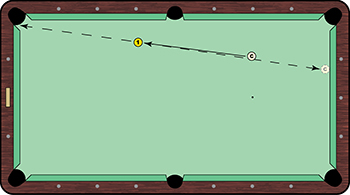Learning to stay down on the shot takes practice.
The majority of the practice drills I share with readers focus on control of the cue ball through speed, spin, angles and more. But all of those drills start with the assumption that you pocket the object ball. (Except, of course, for safety drills.) Of course, misses happen, but itís almost never because your aim was off. Misses happen because you miss the proper contact point on the cue ball. A few things can cause that: faulty stroke, gripping too tight, etc. But one of the biggest culprits in missing shots is head movement.
Moving your head and not staying down on the shot are probably the most common flaws in playersí games. The most frequent instances where this flaw shows itself are on draw shots, power shots and high-pressure shots. Anticipation and anxiety cause the body and arm and mind to tighten up. Because pool is a feel game and requires the use of power to move the cue ball around the table, players put a lot of body into the shots. This was especially true in the older days when the conditions were a lot tougher ó heavier balls, slower cloth, etc. Today, with perfect phenolic balls and finer cloth, less brute strength is needed.
But pool still requires you to spin the ball more than other cue sports, so we tend to have the cue up our body a bit more and our chin is not down on the cue like it is in snooker. Snooker is a more technical game. Players generally use center ball, so precision is the key. They have their chins right down on the cue. I will say that we are starting to see more of technique coming into pool with the younger generations. We are seeing a different style of play and players are working harder than ever on fundamentals and keeping the head and body still.

Still, all pool players ó and I mean everyone from myself and Shane Van Boening, to Jayson Shaw and Earl Strickland ó have a slight head movement when they shoot. But whatís important is that they all follow the object ball to the pocket with their eyes before they come off the shot. So, staying down and keeping your head completely still are two different things but lead to the same result. Most players break down by choking the butt of the cue, which causes their head to move quickly from the cue and results in their shoulder dropping. It may be difficult to see, but these movements cause players to actually start lifting their head before making contact with the cue ball. Their eye moves too quickly to the object ball and they donít contact the cue ball where they intended to.
Obviously, if you have a coach or instructor, they can watch what youíre doing wrong and correct it, at least temporarily. They can put a cue over your head or their hand on your shoulder when you shoot, giving you a better understanding and feel for what you are doing wrong.
For solo training, I have my own process to work on this part of the game. When I strike the cue ball, I watch it hit the object ball and I watch the object ball until it drops into the pocket. My eyes follow the object ball all the way into the pocket. I donít come up off the shot until the object ball disappears. If you take that approach, youíll see massive improvement almost immediately. Youíll start sighting the ball better and timing the ball better.
I work on this part of my game before every practice session by doing the simple drill shown in the diagram. I know that once Iíve got the shot down, Iím good with the basic fundamentals and Iím ready for my practice session. Itís a simple routine and it applies to all levels of player.
Shoot this shot at least 20 times in a row. Itís a straight shot. Pocket the object ball and draw the cue ball back up to the top rail. Focus on a nice, loose grip on the butt, but most of all, follow the object ball to the pocket with your eyes and donít get back up until the ball has disappeared into the pocket. Be sure to aim as low as possible on this shot. A lot of amateurs aim too high on the cue ball, which results in hitting the cue ball too hard. Use a nice, smooth stroke. As long as you hit the cue ball before the cloth, you wonít miscue.
Remember, the keys to staying down are a nice, loose grip and driving through the cue ball for good timing.
No one is perfect with their fundamentals, but if you put the work in, these things will become second nature. You wonít even have to think about it and your game will improve.





